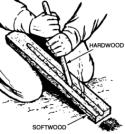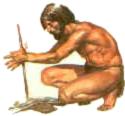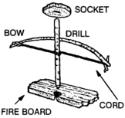
Fire by Friction
Fire by Friction
Rather than creating a spark into tinder, fire by friction causes the fuel to heat up until it reaches the combustion temperature and ignites. This is around 800 degrees fahrenheit. Moisture is the biggest obstacle to overcome when attempting to create fire by rubbing wood. Start with extremely dry wood and keep it dry to ensure success. In areas of higher humidity, more effort is required.
Following are some of the more common methods of creating fire by friction in order of increasing complexness. All of these methods create a coal of smoldering wood dust which is then transfered to waiting tinder to be coaxed into flame. They also employ one piece of hard wood and another slightly softer wood which wears away. Neither of these woods should be too soft nor too hard. Excessive resin in the wood will also cause failure since it will cause the wood to become polished and smooth.
These are simple introductions to each method. Individual success depends on strength, practice, materials used, and troubleshooting. These methods require a lot of effort and consistency.
Some woods to consider using:
- Cedar
- Willow and Redwood
- Yucca and Oak
Fire Plow

- Form a plow board of softer wood that is flat and a couple inches across and 2 feet long.
- Form a plow stick that is hardwood and has a sharpened tip.
- Cut or rub a depression about 6 or 8 inches long in the plow board. This is the trough in which you will scrape the plow stick.
- Hold the plow board firm as shown or kneel on it or sit on it if it is a longer board. The idea is to keep the board steady.
- Point the plow stick into the plow board at about a 60 degree angle and push it forward with downward pressure.
- Release the downward pressure and pull the plow stick back to the start of the trough.
- Push and pull the plow stick quickly, creating wood dust at the far end of the trough. It is important to end each stroke at the same spot so dust can accumulate there.
- Eventually, the wood dust will combust and can be pushed into waiting tinder.
Fire Saw

- a softer wood stick is cracked along its length (but not completely split) and a small peg or pebble is placed in the end to hold the two halves apart about 1/4 inch. You may want to tightly wrap the end which you do not want to split before cracking.
- Tinder is stuffed in the crack.
- A sharp edged harder wood stick is sawn back and forth across the crack, perpendicular to it.
- Sawdust is worn away and drops into the tinder, eventually heating enough to develop a coal.
- Dried bamboo stalks are also used for fire saws with a notch cut across half a stock and the ember falls through the cut onto tinder under the hollow bamboo stalk.
Hand Drill
 A smooth, straight shaft of wood is spun between the palms of the hands, forcing the tip of it into the hearth wood, generating an ember.
A smooth, straight shaft of wood is spun between the palms of the hands, forcing the tip of it into the hearth wood, generating an ember.
- Choose a straight stalk or stick of a harder wood for your drill. It should be about 18 to 24 inches long, 1/4 to 1/2 inch wide, with very few side branches, preferably none.
- Smooth the drill of all bumps, knobs, and roughness so it will not rip up your palms.
- Create a hearth board about 1/4 to 1/2 inch thick and 1 inch wide. Split a piece of softer wood to form a fairly flat surface.
- Cut a small depression in the top of the hearth board about 1/8 inch in from a side. This is where you will seat the drill.
- Hold the hearth board firm with a knee and position the drill in the depression.
- Spin the drill between your palms to wear out the depression and see that the drill seats well.
- Carve a notch half way in to the center of the depression from the edge. As you spin the drill, the wood dust collects in this notch so place a piece of bark under this area to catch it.
- Spin the drill, repositioning your hands at the top when they work their way to the bottom.
- Over time, the wood dust will accumulate and ignite with smoke and finally a small ember. Transfer it to tinder.
Bow Drill
 The bow drill is the most common primitive fire making method demonstrated at shows and classes.
The bow drill is the most common primitive fire making method demonstrated at shows and classes.
- The fire board is a flat piece of softer wood with a depression and notch like the hand drill.
- The drill is a smooth, straight stick of harder wood. The top end shout be pointed and smooth. The drilling end should be rounded.
- The bow has a cord tied between the two ends and wrapped once around the drill.
- The socket holds the drill in place and provides downward pressure. It should have an indentation into which the drill end seats smoothly. Lubricate it with resin or oil from your skin.
- While pressing down on the socket, move the bow back and forth, causing the drill to burn into the fire board.
- Collect the ember and start your fire.
Move Along: Fire Pistons
Find more Campfire Resources at CampfireDude.com


Recent Comments